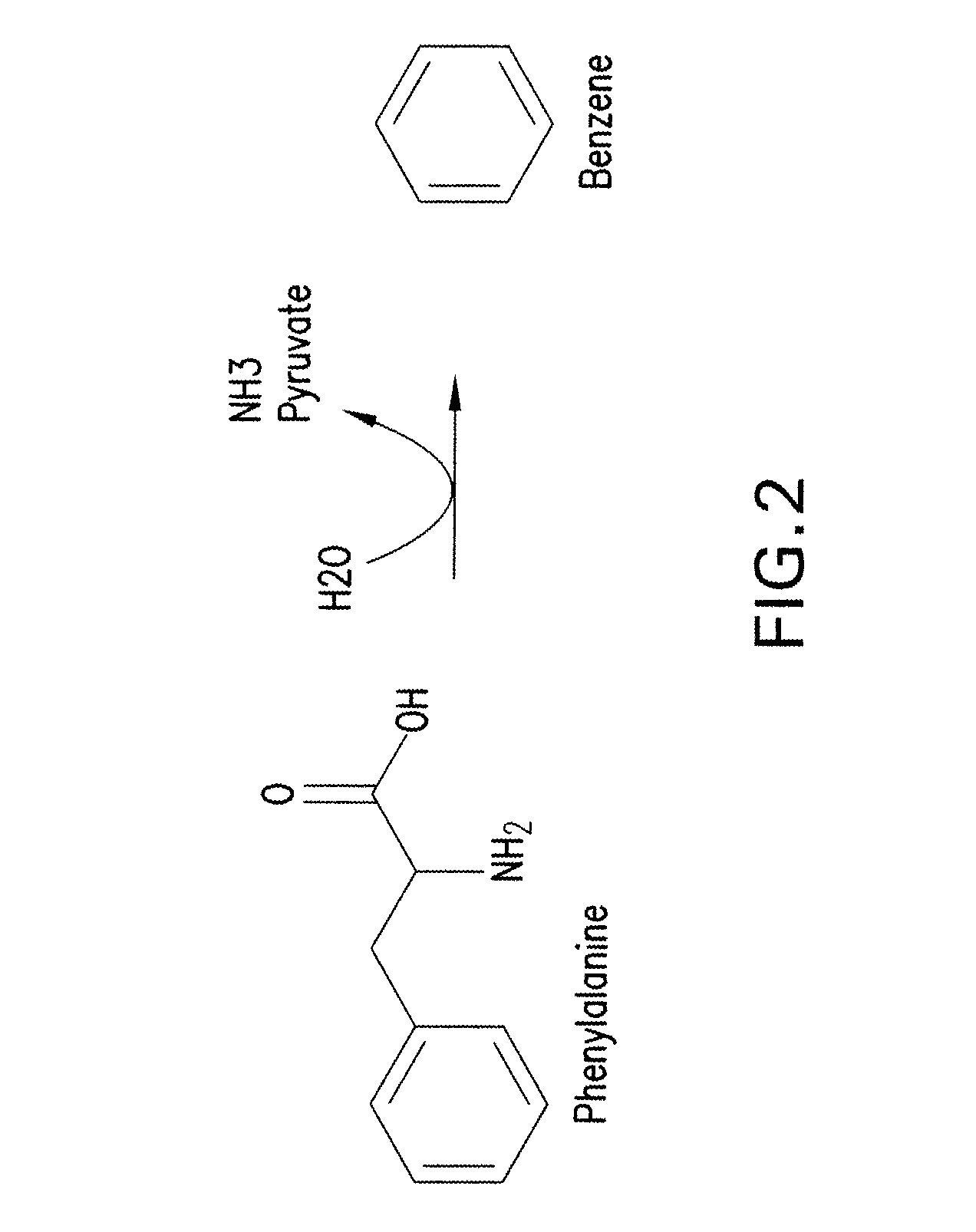Microorganisms and methods for the biosynthesis of aromatics, 2,4-pentadienoate and 1,3-butadiene
a biosynthesis method and microorganism technology, applied in biofuels, enzymology, peptide/protein ingredients, etc., can solve the problems of low biosynthetic efficiency of pta, limited pta biosynthesis pathways, and undeveloped cost-effective methods for generating renewable pta to da
- Summary
- Abstract
- Description
- Claims
- Application Information
AI Technical Summary
Problems solved by technology
Method used
Image
Examples
example i
Pathways to Benzene and Toluene
[0315]This example shows pathways from phenylalanine to toluene, phenylalanine to benzene and benzoyl-CoA to styrene.
[0316]Pathways for enzymatic conversion of phenylalanine are shown in FIG. 1. The first step entails conversion of phenylalanine to phenylpyruvate, a transformation that can be accomplished by an aminotransferase or a deaminating oxidoreductase. Phenylpyruvate is then decarboxylated to phenylacetaldehyde in Step B of FIG. 1. Toluene may be produced directly from phenylacetaldehyde by decarbonylation (FIG. 1, Step E), or indirectly via a phenylacetate intermediate (FIG. 1, Steps C and D). Phenylacetate can be oxidized to phenylacetate (FIG. 1, Step C) by either a phenylacetaldehyde dehydrogenase or a phenylacetaldehyde oxidase. An alternate pathway is the direct oxidative decarboxylation of phenylpyruvate to phenylacetate by phenylpyruvate oxidase (FIG. 1, Step F).
[0317]A one-step pathway for enzymatic conversion of phenylalanine to benze...
example ii
Pathways to 1,3-Butadiene from Muconate Isomers
[0376]This example shows pathways from muconate isomers to 1,3-butadiene.
[0377]FIG. 4 shows the conversion of muconate isomers to 1,3-butadiene by decarboxylase enzymes. Cis,cis-muconate, cis,trans-muconate or trans,trans-muconate is first decarboxylated to either cis-2,4-pentadienoate or trans-2,4-pentadienoate (Steps A, B, C and D of FIG. 4). 2,4-Pentadienoate is subsequently decarboxylated to form 1,3-butadiene (Steps E, F of FIG. 4).
[0378]It is understood that the decarboxylation of any muconate isomer can serve as part of a pathway to 1,3-butadiene. The biological production of cis,cis-muconate is well-known in the art (Draths and Frost. J Am Chem. Soc. 116:399-400 (1994); Niu et al. Biotechnol Prog. 18:201-211 (2002); Bang and Choi. J Ferm Bioeng. 79(4):381-383 (1995)). Isomers of muconate can be interconverted by muconate isomerase enzymes in the EC class 5.2.1.
[0379]It is further understood that decarboxylation of either isomer ...
example iii
Exemplary Pathway for Producing (2-Hydroxy-3-methyl-4-oxobutoxy)phosphonate
[0392]This example describes an exemplary pathway for producing the terephthalic acid (PTA) precursor (2-hydroxy-3-methyl-4-oxobutoxy)phosphonate (2H3M4OP).
[0393]The precursor to the p-toluate and PTA pathways is 2H3M4OP. This chemical can be derived from central metabolites glyceraldehyde-3-phosphate (G3P) and pyruvate in three enzymatic steps as shown in FIG. 5. The first two steps are native to E. coli and other organisms that utilize the methylerythritol phosphate (non-mevalonate) pathway for isoprenoid biosynthesis. Pyruvate and G3P are first condensed to form 1-deoxy-D-xylulose 5-phosphate (DXP) by DXP synthase. Subsequent reduction and rearrangement of the carbon backbone is catalyzed by DXP reductoisomerase. Finally, a novel diol dehydratase transforms 2-C-methyl-D-erythritol-4-phosphate to the p-toluate precursor 2H3M4OP.
[0394]A. 1-Deoxyxylulose-5-Phosphate (DXP) Synthase.
[0395]Pyruvate and G3P are c...
PUM
 Login to View More
Login to View More Abstract
Description
Claims
Application Information
 Login to View More
Login to View More - R&D
- Intellectual Property
- Life Sciences
- Materials
- Tech Scout
- Unparalleled Data Quality
- Higher Quality Content
- 60% Fewer Hallucinations
Browse by: Latest US Patents, China's latest patents, Technical Efficacy Thesaurus, Application Domain, Technology Topic, Popular Technical Reports.
© 2025 PatSnap. All rights reserved.Legal|Privacy policy|Modern Slavery Act Transparency Statement|Sitemap|About US| Contact US: help@patsnap.com



